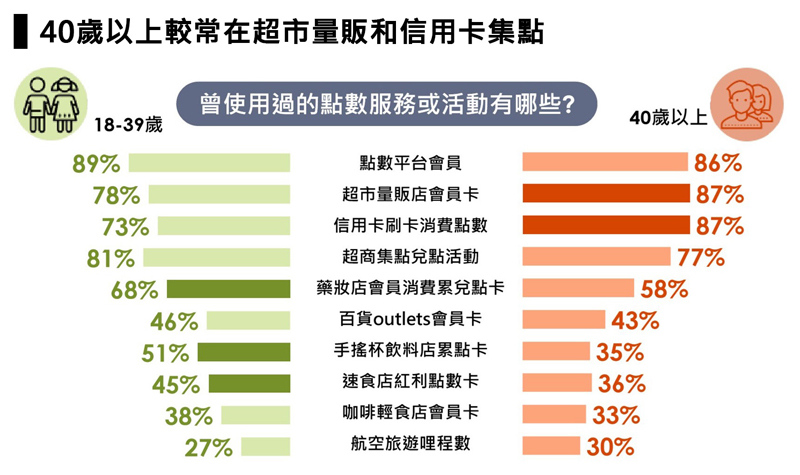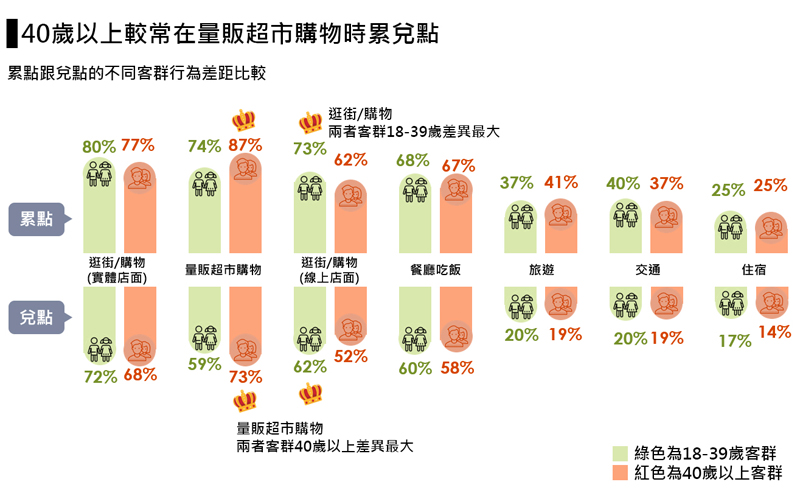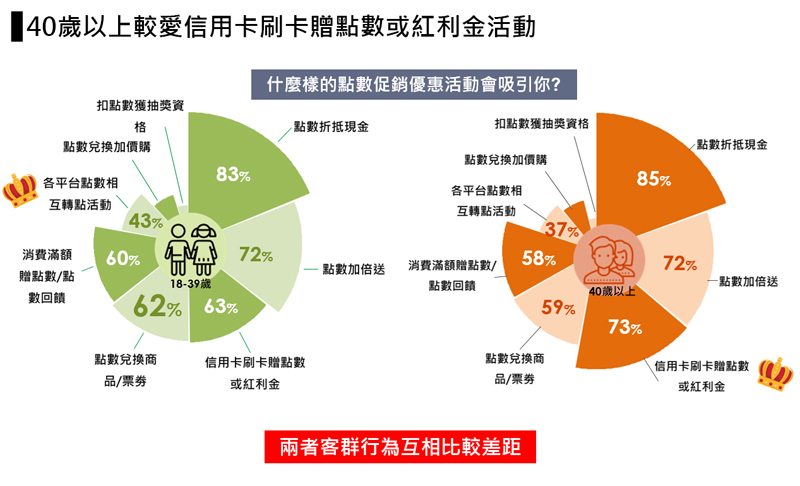12.2019 Office Talk
The gold mine in the marketing, dig the psychology of "points" of the era.
Tianxia innovation college /

Happy go is 15 years old! Since the launch of happy go, it has won nearly 70% market share of consumer comp points platform! For this reason, go supply deeply explores the current public's use of points in various life situations. Through behavior observation, it can understand the latest trend of consumer's use of points and suggestions for future point service.
Nearly 90% of the Chinese people love collecting places and are lucky to save money
 According to go survey, up to 87% of Chinese have used point platform services. In addition to the point platform, people will also use the points service of supermarket (83%), credit card (80%) and supermarket (79%). Among them, 18-39-year-olds often use drug make-up, hand-held drinks and fast food shop point service; over 40-year-olds often use supermarket wholesale and credit card point service.
According to go survey, up to 87% of Chinese have used point platform services. In addition to the point platform, people will also use the points service of supermarket (83%), credit card (80%) and supermarket (79%). Among them, 18-39-year-olds often use drug make-up, hand-held drinks and fast food shop point service; over 40-year-olds often use supermarket wholesale and credit card point service.
Points service can combine with the product feedback of physical cosmetics, hand-held stores and fast food stores to create small savings and consumption, increase the love for points of 18-39-year-old customers, and further enhance the brand adhesion. In order to stimulate the consumption of customers over 40 years old, we can use supermarkets and credit card counting activities to create the opportunity to use points.
How to start a set point? There are generational differences in trigger points
 The main reasons for people to start using point service are "often consuming in this store, so they apply" (63%), "in order to get cash feedback" (62%), "shopping shops just have activities to join" (55%), "credit cards just have point service function" (55%).
The main reasons for people to start using point service are "often consuming in this store, so they apply" (63%), "in order to get cash feedback" (62%), "shopping shops just have activities to join" (55%), "credit cards just have point service function" (55%).
Customers aged 18-39 are often used for cash feedback, downloading store app, purchasing goods, recommendation from relatives and friends, and using with their families; customers over 40 are often used for credit card discount. The stores that people often consume, combined with the point service platform, can use the point discount cash feedback activity or the credit card application activity to recruit new customers for the store, trigger the point application of new customers, and expand the number of target customers.
Time for shopping and shopping
 In terms of accumulated points or exchange points, when shopping / shopping, mass selling / supermarket shopping or dining in restaurants, it is the main time to accumulate points. Customers aged 18-39 are more likely to shop online and those aged over 40 are more likely to shop in supermarkets. The point service can combine the scene that people often accumulate points, activate the use of consumption points, and create additional consumption opportunities.
In terms of accumulated points or exchange points, when shopping / shopping, mass selling / supermarket shopping or dining in restaurants, it is the main time to accumulate points. Customers aged 18-39 are more likely to shop online and those aged over 40 are more likely to shop in supermarkets. The point service can combine the scene that people often accumulate points, activate the use of consumption points, and create additional consumption opportunities.
What do people exchange for? Generation needs are very different
The results show that 18-39 years old prefer to exchange points for new line maps or mobile phone themes, as well as fruit juice drinks, Japanese snacks, and tourism related products; while Chinese snacks, small household appliances, coffee and tea bags, and household cleaning products can more promote customers over 40 years old to exchange points. When the items that people can exchange with points are more diversified, more kinds and higher CP value, the point value will become larger and more popular.
What is the most attractive point promotion?
 What kind of points promotion will attract people? The survey found that points converted into cash (84%), points doubled (72%) and credit card free points (68%) were the most attractive points preferential activities. In addition, 18-39-year-olds love the activity of turning points among platforms; over 40-year-olds prefer the activity of credit card credit card free points or bonus. It can make the marketing activities more effective to provide the right number of promotions for different customers.
What kind of points promotion will attract people? The survey found that points converted into cash (84%), points doubled (72%) and credit card free points (68%) were the most attractive points preferential activities. In addition, 18-39-year-olds love the activity of turning points among platforms; over 40-year-olds prefer the activity of credit card credit card free points or bonus. It can make the marketing activities more effective to provide the right number of promotions for different customers.
The perfect combination of point economy and people's consumption life is the key to the sustainable development of point economy. If the point service can be combined with consumers' preferences, the daily needs or extended services in different life scenarios will be more stimulating for consumption, such as making good use of daily necessities (such as bottled water and toilet paper), as well as practical tools (such as mobile phones and communication related peripheral goods), or tea drinks, coffee, refrigerated food, baked Western point and snacks, etc., which can attract the point of exchange, and even Cash discount, commodity exchange, credit card free points and other activities to stimulate consumption.
In the future, point service can move towards the "point ecosystem", deepen the point management of target customers, and activate the use of points, including daily food, clothing, housing, transportation and other aspects, so as to accumulate and spend points, so that consumers can have higher viscosity in brand and store in a universal point across channels and platforms.
The survey shows that "point usage behavior survey" is the online survey conducted by go survey market research consultant on go survey platform from February 6, 2019 to March 5, 2019. A total of 2865 samples were collected. The interviewees were happy go card friends who were over 18 years old and had used the counting platform in the past.
Nearly 90% of the Chinese people love collecting places and are lucky to save money

Points service can combine with the product feedback of physical cosmetics, hand-held stores and fast food stores to create small savings and consumption, increase the love for points of 18-39-year-old customers, and further enhance the brand adhesion. In order to stimulate the consumption of customers over 40 years old, we can use supermarkets and credit card counting activities to create the opportunity to use points.
How to start a set point? There are generational differences in trigger points

Customers aged 18-39 are often used for cash feedback, downloading store app, purchasing goods, recommendation from relatives and friends, and using with their families; customers over 40 are often used for credit card discount. The stores that people often consume, combined with the point service platform, can use the point discount cash feedback activity or the credit card application activity to recruit new customers for the store, trigger the point application of new customers, and expand the number of target customers.
Time for shopping and shopping

What do people exchange for? Generation needs are very different
The results show that 18-39 years old prefer to exchange points for new line maps or mobile phone themes, as well as fruit juice drinks, Japanese snacks, and tourism related products; while Chinese snacks, small household appliances, coffee and tea bags, and household cleaning products can more promote customers over 40 years old to exchange points. When the items that people can exchange with points are more diversified, more kinds and higher CP value, the point value will become larger and more popular.
What is the most attractive point promotion?

The perfect combination of point economy and people's consumption life is the key to the sustainable development of point economy. If the point service can be combined with consumers' preferences, the daily needs or extended services in different life scenarios will be more stimulating for consumption, such as making good use of daily necessities (such as bottled water and toilet paper), as well as practical tools (such as mobile phones and communication related peripheral goods), or tea drinks, coffee, refrigerated food, baked Western point and snacks, etc., which can attract the point of exchange, and even Cash discount, commodity exchange, credit card free points and other activities to stimulate consumption.
In the future, point service can move towards the "point ecosystem", deepen the point management of target customers, and activate the use of points, including daily food, clothing, housing, transportation and other aspects, so as to accumulate and spend points, so that consumers can have higher viscosity in brand and store in a universal point across channels and platforms.
The survey shows that "point usage behavior survey" is the online survey conducted by go survey market research consultant on go survey platform from February 6, 2019 to March 5, 2019. A total of 2865 samples were collected. The interviewees were happy go card friends who were over 18 years old and had used the counting platform in the past.

















